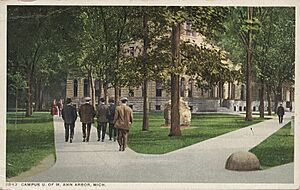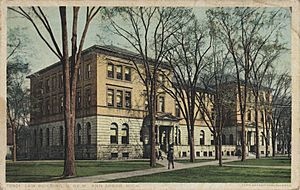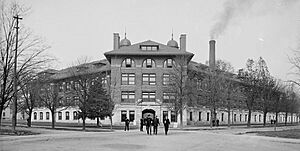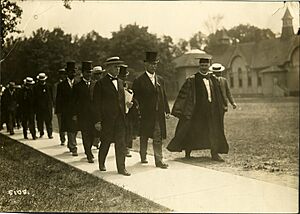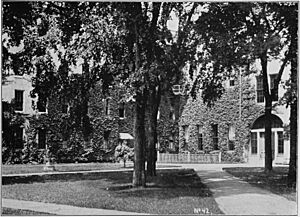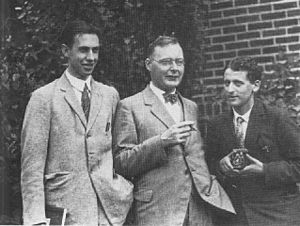History of the University of Michigan facts for kids
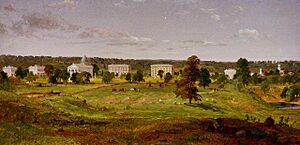
The history of the University of Michigan started on August 26, 1817. It was first called the Catholepistemiad or University of Michigania.
Contents
Early Beginnings (1817–1837)
The Catholepistemiad
After the Territory of Michigan was formed in 1805, leaders saw a need for education. In 1817, a judge named Augustus B. Woodward created a plan. He wanted to start a "Catholepistemiad, or University of Michigania."
This university would have 13 different teaching areas, called didaxiim. Woodward made up special names for these areas using Greek and Latin words. For example, Mathematica was for Mathematics and Astronomia was for Astronomy.
The professors, called Didactors, would control all education in the territory. They could set up colleges, academies, schools, and libraries.
The act to create this university was signed on August 26, 1817. Two religious leaders, Father Gabriel Richard and Rev. John Monteith, became the first professors.
To help fund the university, a group called Zion Lodge No. 1 of Detroit gave $250. This was a big part of the money needed to start the university.
The first building's cornerstone was laid on September 24, 1817, in Detroit. Soon, a primary school and a classical academy opened there.
Just five days later, a treaty was signed with Native American tribes. The Chippewa, Ottawa, and Potawatomi tribes gave 1,920 acres (7.8 km²) of land to the "college at Detroit." This land was meant to be used or sold to support the school.
A New Name for the University
The long name "Catholepistemiad" was hard to say and often made people laugh. People called it the "Cathole-what's its name."
So, on April 30, 1821, a new law was passed. It changed the school's name to the University of Michigan. Control was given to a Board of Trustees.
The primary school and academy continued to operate for a while. But by 1827, they had closed. The University of Michigan mostly existed only on paper for some time.
The University in the 1800s

| School |
|
| Literature, Science, and the Arts |
|
| Medicine |
|
| Engineering |
|
| Law |
|
| Dentistry |
|
| Pharmacy |
|
| Music, Theatre & Dance |
|
| Nursing |
|
| Architecture & Urban Planning |
|
| Graduate Studies |
|
| Government |
|
| Education |
|
| Business |
|
| Environment and Sustainability |
|
| Public Health |
|
| Social Work |
|
| Information |
|
| Art & Design |
|
| Kinesiology |
|
Founding in Ann Arbor
When Michigan became a state in 1837, a new law created the University of Michigan again. This time, it would be in Ann Arbor. A group of businessmen had set aside land there for a state capital. When that didn't happen, they offered the land to the university.
The first classes were held in 1841. Six freshmen and one sophomore were taught by two professors. In 1845, eleven students were the first to graduate.
In 1850, a new state constitution was adopted. It made the university's leaders, called Regents, elected by the people. It also created the job of President of the University of Michigan. In 1852, Henry Philip Tappan became the first president.
Growing the University
President Tappan wanted the University of Michigan to be like the best universities in Germany. He added more books to the library and helped create laboratories and an art gallery. He also supported the Detroit Observatory.
The Medical School started in 1848. In 1869, UM opened the first university-owned hospital in the U.S.
By 1865, over 1,200 students were enrolled. Many were veterans from the American Civil War. The university started attracting students from all over the U.S. and other countries. African Americans also began attending.
In 1867, students voted for maize and blue as the class colors. These became the official colors of the university in 1912.
The first known African American student, Samuel Codes Watson, joined in 1853. The first female student, Madelon Louisa Stockwell, was admitted in 1870. The first known African American woman, Mary Henrietta Graham, was admitted in 1876.
In 1871, James Burrill Angell became president. He greatly expanded the university's courses. He added professional studies like dentistry, architecture, engineering, and more medicine. President Angell also helped bring many foreign students to the university.
Michigan in the 1900s
President Marion LeRoy Burton started in 1920. During his time, the university began big research projects around the world. He also made the classes harder and tried to calm down students' social lives. The memorial bell tower on campus is named after him.
The university became a major research center in 1920. The College of Engineering was reorganized. In 1933, the new Law Quadrangle was finished. It was a gift from a former student, William W. Cook.
During World War II, the university became a research powerhouse. It worked on projects for the U.S. Navy. Researchers helped develop new weapons and technologies.
By 1950, 21,000 students were enrolled. Many were veterans supported by the G.I. Bill. The university also bought 300 acres (1.2 km²) of land for what would become North Campus.
| University Presidents | |
|---|---|
| President | Years |
|
|
|
| Rev. John Monteith | 1817–1821 |
| none (Board of Trustees) | 1821–1837 |
| none (Board of Regents) | 1837–1852 |
| Henry Philip Tappan | 1852–1863 |
| Erastus Otis Haven | 1863–1869 |
| Henry S. Frieze* | 1869–1871 |
| James Burrill Angell | 1871–1909 |
| Henry S. Frieze* | 1880–1882 |
| Henry S. Frieze* | 1887–1888 |
| Harry Burns Hutchins* | 1897–1898 |
| Harry Burns Hutchins* | 1909–1910 |
| Harry Burns Hutchins | 1910–1920 |
| Marion LeRoy Burton | 1920–1925 |
| Alfred Henry Lloyd* | 1925 |
| Clarence Cook Little | 1925–1929 |
| Alexander Grant Ruthven | 1929–1951 |
| Harlan Hatcher | 1951–1968 |
| Robben Wright Fleming | 1968–1979 |
| Allan Frederick Smith* | 1979 |
| Harold Tafler Shapiro | 1980–1988 |
| Robben Wright Fleming* | 1988 |
| James Johnson Duderstadt | 1988–1996 |
| Homer A. Neal* | 1996 |
| Lee C. Bollinger | 1996–2002 |
| B. Joseph White* | 2002 |
| Mary Sue Coleman | 2002–2014 |
| Mark S. Schlissel | 2014–2022 |
| Mary Sue Coleman* | 2022 |
| Santa Ono | 2022–present |
| *Means acting or temporary president See also President of the University of Michigan |
|
In 1951, Harlan Hatcher became president. He helped build North Campus and created an Honors College for top students. During the Cold War and Space Race, UM received many government research grants. Its scientists explored peaceful uses for atomic power.
A Time of Change and Activism
In the 1960s, many UM professors worked for presidents Lyndon Johnson and John F. Kennedy. On October 14, 1960, President Kennedy announced his idea to form the Peace Corps at the Michigan Union.
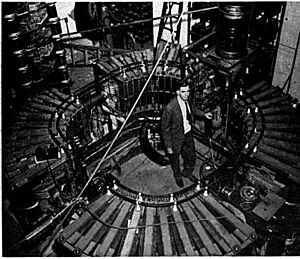
The 1960s also saw a big increase in student activism. On March 24, 1964, professors held the nation's first "teach-in." They protested American policy in Southeast Asia, and 2,500 students attended.
On November 5, 1962, Martin Luther King Jr. gave two speeches at Hill Auditorium. He said, "The American dream is as yet unfulfilled."
Students also protested low minority enrollment. In March 1970, the Black Action Movement organized a strike. They wanted more minority students and an African American Studies department. The university agreed to many of their demands.
During the 1970s, money problems slowed the university's growth. But in the 1980s, President Harold Tafler Shapiro helped improve the university's finances. A new hospital complex opened in 1986.
President James Duderstadt (1988-1995) focused on computer and information technology. He also helped with campus growth and fundraising.
The University Today
In the early 2000s, the University of Michigan faced less money from the state. But it has worked to keep its high academic standards. It also tries to keep tuition costs fair.
The university has spent billions of dollars on new buildings. It has added over 1 million square feet (90,000 m²) of space for science research. New buildings include the Cardiovascular Center and a new children's hospital.
Campus History
The Ann Arbor campus first started on 40 acres (16 ha) of land. This area is now known as Central Campus.
The early 1900s saw a lot of building construction. New facilities for dental and pharmacy programs were built. There was also a chemistry building, natural sciences building, and residence halls. Hill Auditorium and large hospital and library complexes were also built.
In 1925, The University Hospital opened. It was designed by Albert Kahn. This 893-bed hospital was the largest and most modern of its kind.
Land for North Campus was bought in 1950. This area would house the College of Engineering and the School of Music.
In the 1980s and 1990s, the university renovated its hospital. It also improved academic buildings on North Campus. In 1997, the University of Michigan Health System was formed. This brought together the Medical School and Hospitals.
Today, the Ann Arbor campus has four main areas: North, Central, Medical, and South Campuses. It has over 500 major buildings. These buildings cover more than 37.48 million square feet (3.48 km²). The university also has other facilities, like the Matthaei Botanical Gardens.


